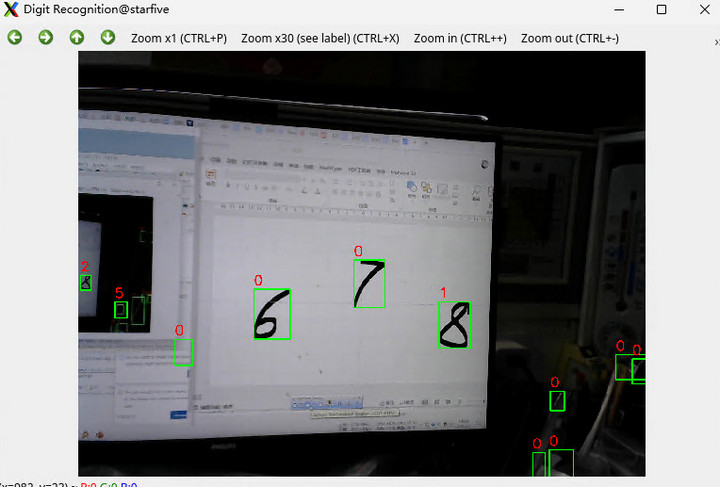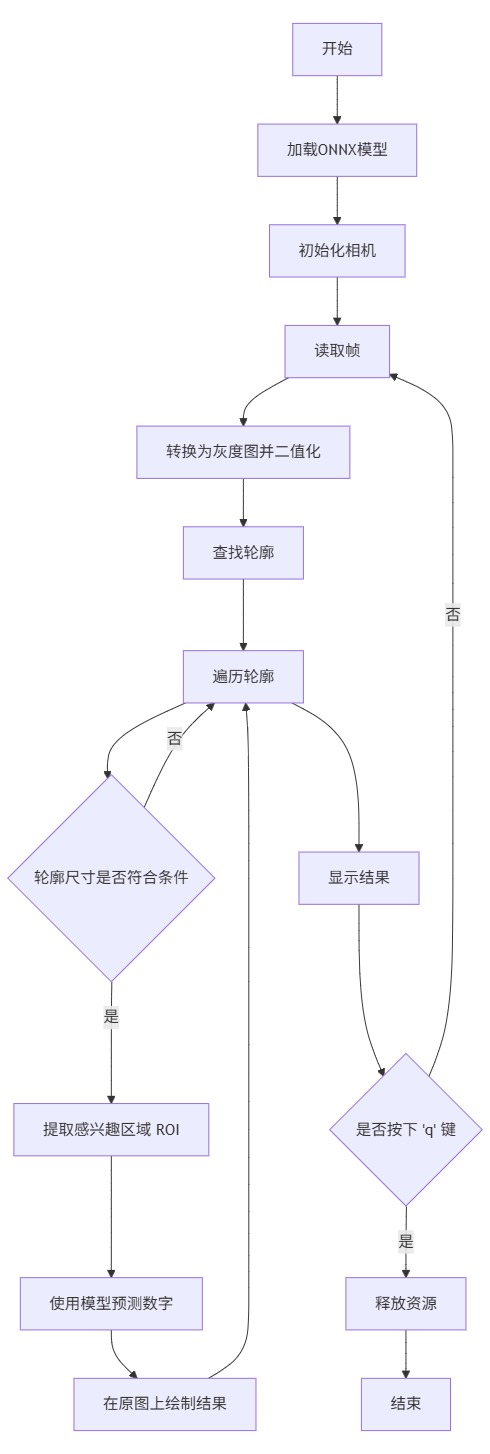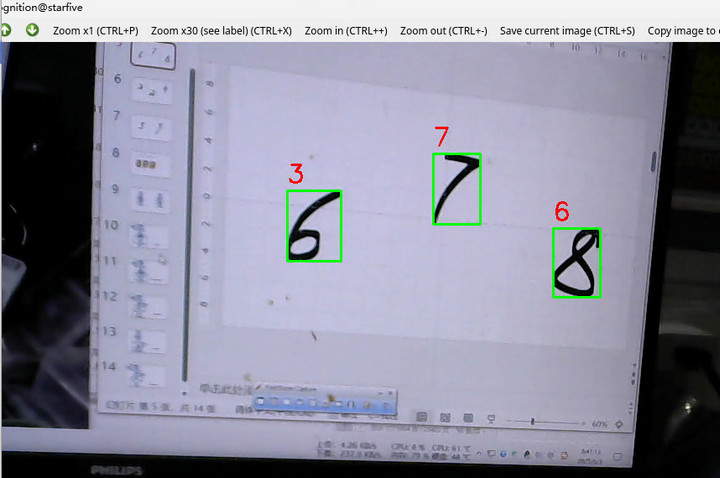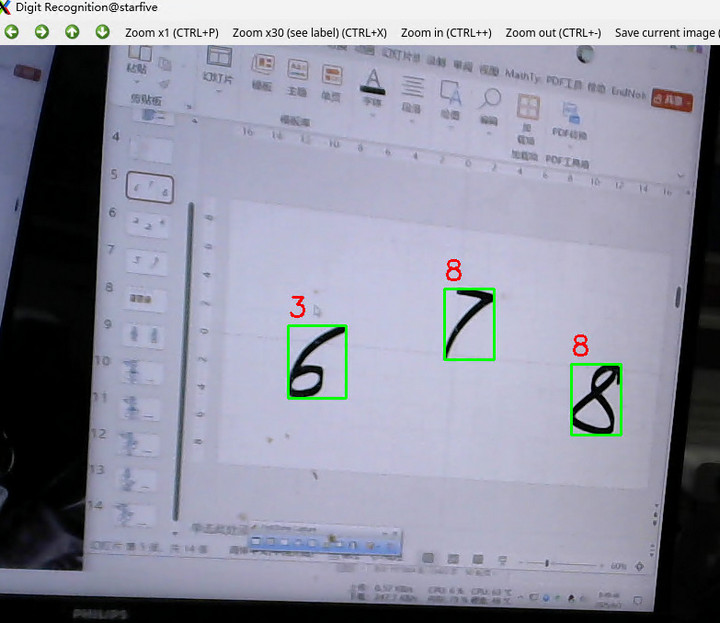【昉·星光2 RISC-V 单板计算机】数字识别
本文介绍了昉·星光2单板计算机实现 数字识别 的项目设计。
OpenCV
调用 OpenCV 库进行数字识别
流程图

代码
import cv2
import numpy as np
# Initialize the camera
def init_camera(camera_index=4):
cap = cv2.VideoCapture(camera_index)
if not cap.isOpened():
raise RuntimeError("Unable to open the camera, please check the connection")
return cap
# Preprocess the image
def preprocess_image(img):
# Convert to grayscale
gray = cv2.cvtColor(img, cv2.COLOR_BGR2GRAY)
# Apply Gaussian blur for noise reduction
blurred = cv2.GaussianBlur(gray, (5, 5), 0)
# Adaptive thresholding to binarize the image
binary = cv2.adaptiveThreshold(
blurred, 255,
cv2.ADAPTIVE_THRESH_GAUSSIAN_C,
cv2.THRESH_BINARY_INV, 11, 2
)
# Morphological operations
kernel = cv2.getStructuringElement(cv2.MORPH_RECT, (3, 3))
processed = cv2.morphologyEx(binary, cv2.MORPH_CLOSE, kernel)
return processed
# Find digit regions
def find_digit_regions(image):
# Find contours
contours, _ = cv2.findContours(
image, cv2.RETR_EXTERNAL, cv2.CHAIN_APPROX_SIMPLE
)
digit_rects = []
for cnt in contours:
x, y, w, h = cv2.boundingRect(cnt)
# Filter out small regions
if w > 20 and h > 30 and w < 200 and h < 200:
aspect_ratio = w / float(h)
if 0.2 < aspect_ratio < 1.2: # Digits are usually close to square
digit_rects.append((x, y, w, h))
# Sort by x-coordinate (left to right)
digit_rects.sort(key=lambda rect: rect[0])
return digit_rects
# Simple digit recognition (should be replaced with a more complex model in real applications)
def recognize_digit(roi):
# Preprocess the ROI
resized = cv2.resize(roi, (28, 28))
normalized = resized / 255.0
# This should be your model inference code
# Example: A simple decision logic
mean_intensity = np.mean(normalized)
if mean_intensity < 0.3:
return "0"
elif 0.3 <= mean_intensity < 0.4:
return "1"
elif 0.4 <= mean_intensity < 0.5:
return "2"
else:
return str(int(mean_intensity * 10 % 10)) # Example logic
def main():
# Initialize the camera
cap = init_camera()
# Create a window
cv2.namedWindow("Digit Recognition", cv2.WINDOW_NORMAL)
try:
while True:
# Capture a frame
ret, frame = cap.read()
if not ret:
print("Unable to capture frame, exiting...")
break
# Preprocess the image
processed = preprocess_image(frame)
# Find digit regions
digit_rects = find_digit_regions(processed)
# Recognize and label each digit
for (x, y, w, h) in digit_rects:
# Extract ROI
roi = processed[y:y+h, x:x+w]
# Recognize the digit
digit = recognize_digit(roi)
# Draw a rectangle around the digit
cv2.rectangle(frame, (x, y), (x+w, y+h), (0, 255, 0), 2)
# Display the recognition result at the top-left corner
cv2.putText(
frame, digit, (x, y-10),
cv2.FONT_HERSHEY_SIMPLEX, 1, (0, 0, 255), 2
)
# Display the result
cv2.imshow("Digit Recognition", frame)
# Exit on 'q' key press
if cv2.waitKey(1) & 0xFF == ord('q'):
break
finally:
# Release resources
cap.release()
cv2.destroyAllWindows()
if __name__ == "__main__":
main()识别速度较快,无卡顿

识别灵敏度过高,导致误识别概率过大。
ONNX 模型
通过调用训练完成的 ONNX 模型,提升转化效率和识别效果。
流程图

代码
使用 OpenCV 的 DNN 库对模型进行解析
import cv2
import numpy as np
class DigitRecognizer:
def __init__(self, onnx_model_path="mnist-8.onnx"):
# Load the ONNX model using OpenCV DNN
self.net = cv2.dnn.readNetFromONNX(onnx_model_path)
print("Model loaded successfully!")
def preprocess(self, img):
"""Preprocess the image for model input format (1, 1, 28, 28)"""
gray = cv2.cvtColor(img, cv2.COLOR_BGR2GRAY) # Convert to grayscale
resized = cv2.resize(gray, (28, 28)) # Resize
normalized = resized.astype(np.float32) / 255.0 # Normalize to [0,1]
blob = cv2.dnn.blobFromImage(normalized) # Convert to (1,1,28,28)
return blob
def predict(self, img):
"""Predict the digit (0-9)"""
blob = self.preprocess(img)
self.net.setInput(blob)
output = self.net.forward() # Inference
return np.argmax(output) # Return the class with the highest probability
def main():
# Initialize the recognizer
recognizer = DigitRecognizer("mnist-8.onnx")
# Initialize the camera
cap = cv2.VideoCapture(4)
cap.set(cv2.CAP_PROP_FRAME_WIDTH, 640)
cap.set(cv2.CAP_PROP_FRAME_HEIGHT, 480)
print("Digit recognition program has started, press 'q' to exit...")
try:
while True:
ret, frame = cap.read()
if not ret:
print("Unable to capture video frame")
break
# Convert to grayscale and binarize
gray = cv2.cvtColor(frame, cv2.COLOR_BGR2GRAY)
_, binary = cv2.threshold(gray, 0, 255, cv2.THRESH_BINARY_INV + cv2.THRESH_OTSU)
# Find contours
contours, _ = cv2.findContours(binary, cv2.RETR_EXTERNAL, cv2.CHAIN_APPROX_SIMPLE)
for cnt in contours:
x, y, w, h = cv2.boundingRect(cnt)
if 20 < w < 200 and 30 < h < 200: # Filter out small regions
roi = frame[y:y+h, x:x+w]
digit = recognizer.predict(roi) # Predict the digit
# Draw the results
cv2.rectangle(frame, (x, y), (x+w, y+h), (0, 255, 0), 2)
cv2.putText(frame, str(digit), (x, y-10),
cv2.FONT_HERSHEY_SIMPLEX, 1, (0, 0, 255), 2)
cv2.imshow("Digit Recognition (OpenCV DNN)", frame)
if cv2.waitKey(1) & 0xFF == ord('q'):
break
except KeyboardInterrupt:
print("Program interrupted by user")
finally:
cap.release()
cv2.destroyAllWindows()
print("Resources released")
if __name__ == "__main__":
main()识别速度较快,识别效果较 OpenCV 的方案有所提升

替换 onnx 模型,识别准确度依然有限

分析
识别效果与模型、图像分辨率、设定识别范围、分辨率设定等因素有关,具体应用需要进行参数校订。
总结
本文介绍了昉·星光2单板计算机实现 数字识别 的项目设计,为该开发板在人工智能领域的应用和快速开发提供了参考。

